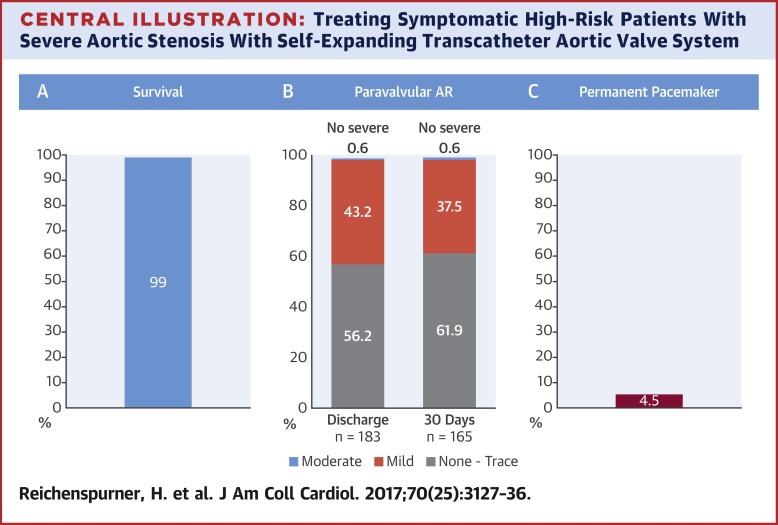当前位置:
X-MOL 学术
›
J. Am. Coll. Cardiol.
›
论文详情
Our official English website, www.x-mol.net, welcomes your
feedback! (Note: you will need to create a separate account there.)
Self-Expanding Transcatheter Aortic Valve System for Symptomatic High-Risk Patients With Severe Aortic Stenosis
Journal of the American College of Cardiology ( IF 21.7 ) Pub Date : 2017-12-01 , DOI: 10.1016/j.jacc.2017.10.060 Hermann Reichenspurner , Andreas Schaefer , Ulrich Schäfer , Didier Tchétché , Axel Linke , Mark S. Spence , Lars Søndergaard , Hervé LeBreton , Gerhard Schymik , Mohamed Abdel-Wahab , Jonathon Leipsic , Darren L. Walters , Stephen Worthley , Markus Kasel , Stephan Windecker
Journal of the American College of Cardiology ( IF 21.7 ) Pub Date : 2017-12-01 , DOI: 10.1016/j.jacc.2017.10.060 Hermann Reichenspurner , Andreas Schaefer , Ulrich Schäfer , Didier Tchétché , Axel Linke , Mark S. Spence , Lars Søndergaard , Hervé LeBreton , Gerhard Schymik , Mohamed Abdel-Wahab , Jonathon Leipsic , Darren L. Walters , Stephen Worthley , Markus Kasel , Stephan Windecker

|
BACKGROUND
The CENTERA transcatheter heart valve (THV) is a low-profile, self-expanding nitinol valve made from bovine pericardial tissue that is 14-F compatible with a motorized delivery system allowing for repositionability. OBJECTIVES
The pivotal study evaluated safety and efficacy of this THV in high-surgical-risk study patients with severe symptomatic aortic stenosis. METHODS
Implantations were completed in 23 centers. Clinical and echocardiographic outcomes were assessed at baseline, discharge, and 30 days. Major events were adjudicated by an independent clinical events committee. Echocardiograms and computed tomography scans were reviewed by core laboratories. The primary endpoint was all-cause mortality at 30 days. RESULTS
Between March 25, 2015 and July 5, 2016, 203 patients with severe symptomatic aortic stenosis and increased surgical risk, as determined by the heart team, were treated by transfemoral THV implantation (age 82.7 ± 5.5 years, 67.5% female, 68.0% New York Heart Association functional class III/IV). At 30 days, mortality was 1%, disabling stroke occurred in 2.5% of patients, and New York Heart Association functional class I/II was observed in 93.0% of patients. Effective orifice area increased from 0.71 ± 0.20 cm2 to 1.88 ± 0.43 cm2 (p < 0.001). Mean aortic transvalvular gradient decreased from 40.5 ± 13.2 mm Hg to 7.2 ± 2.8 mm Hg at 30 days post-procedure (p < 0.001). Paravalvular aortic regurgitation at 30 days was moderate or higher in 0.6% of patients. A new permanent pacemaker was implanted in 4.5% of patients receiving the THV (4.9% for patients at risk). CONCLUSIONS
The herein described THV is safe and effective at 30 days with low mortality, significant improvements in hemodynamic outcomes, and low incidence of adverse events. Of particular interest is the low incidence of permanent pacemaker implantations. (Safety and Performance Study of the Edwards CENTERA-EU Self-Expanding Transcatheter Heart Valve [CENTERA-2]; NCT02458560).
中文翻译:

自膨式经导管主动脉瓣系统用于有症状的重度主动脉瓣狭窄高危患者
背景 CENTERA 经导管心脏瓣膜 (THV) 是一种由牛心包组织制成的低剖面、自膨胀镍钛诺瓣膜,其 14-F 与电动输送系统兼容,允许重新定位。目标 关键研究评估了这种 THV 在具有严重症状性主动脉瓣狭窄的高手术风险研究患者中的安全性和有效性。方法 在 23 个中心完成了植入。在基线、出院和 30 天评估临床和超声心动图结果。主要事件由独立的临床事件委员会裁定。超声心动图和计算机断层扫描由核心实验室审查。主要终点是 30 天时的全因死亡率。结果 2015 年 3 月 25 日至 2016 年 7 月 5 日期间,203 名患有严重症状性主动脉瓣狭窄且手术风险增加的患者(由心脏团队确定)接受了经股骨 THV 植入治疗(年龄 82.7 ± 5.5 岁,67.5% 女性,68.0% 纽约心脏协会功能等级 III/IV)。30 天时,死亡率为 1%,2.5% 的患者发生致残性卒中,93.0% 的患者观察到纽约心脏协会功能分级 I/II。有效孔口面积从 0.71 ± 0.20 cm2 增加到 1.88 ± 0.43 cm2 (p < 0.001)。平均主动脉跨瓣梯度在术后 30 天从 40.5 ± 13.2 毫米汞柱下降到 7.2 ± 2.8 毫米汞柱(p < 0.001)。在 0.6% 的患者中,30 天时瓣周主动脉瓣反流为中度或更高。接受 THV 的患者中有 4.5% 植入了新的永久性起搏器(有风险的患者为 4.9%)。结论本文描述的 THV 在 30 天时安全有效,死亡率低,血流动力学结果显着改善,不良事件发生率低。特别令人感兴趣的是永久性起搏器植入的低发生率。(Edwards CENTERA-EU 自膨式经导管心脏瓣膜 [CENTERA-2] 的安全性和性能研究;NCT02458560)。
更新日期:2017-12-01
中文翻译:

自膨式经导管主动脉瓣系统用于有症状的重度主动脉瓣狭窄高危患者
背景 CENTERA 经导管心脏瓣膜 (THV) 是一种由牛心包组织制成的低剖面、自膨胀镍钛诺瓣膜,其 14-F 与电动输送系统兼容,允许重新定位。目标 关键研究评估了这种 THV 在具有严重症状性主动脉瓣狭窄的高手术风险研究患者中的安全性和有效性。方法 在 23 个中心完成了植入。在基线、出院和 30 天评估临床和超声心动图结果。主要事件由独立的临床事件委员会裁定。超声心动图和计算机断层扫描由核心实验室审查。主要终点是 30 天时的全因死亡率。结果 2015 年 3 月 25 日至 2016 年 7 月 5 日期间,203 名患有严重症状性主动脉瓣狭窄且手术风险增加的患者(由心脏团队确定)接受了经股骨 THV 植入治疗(年龄 82.7 ± 5.5 岁,67.5% 女性,68.0% 纽约心脏协会功能等级 III/IV)。30 天时,死亡率为 1%,2.5% 的患者发生致残性卒中,93.0% 的患者观察到纽约心脏协会功能分级 I/II。有效孔口面积从 0.71 ± 0.20 cm2 增加到 1.88 ± 0.43 cm2 (p < 0.001)。平均主动脉跨瓣梯度在术后 30 天从 40.5 ± 13.2 毫米汞柱下降到 7.2 ± 2.8 毫米汞柱(p < 0.001)。在 0.6% 的患者中,30 天时瓣周主动脉瓣反流为中度或更高。接受 THV 的患者中有 4.5% 植入了新的永久性起搏器(有风险的患者为 4.9%)。结论本文描述的 THV 在 30 天时安全有效,死亡率低,血流动力学结果显着改善,不良事件发生率低。特别令人感兴趣的是永久性起搏器植入的低发生率。(Edwards CENTERA-EU 自膨式经导管心脏瓣膜 [CENTERA-2] 的安全性和性能研究;NCT02458560)。









































 京公网安备 11010802027423号
京公网安备 11010802027423号